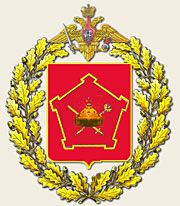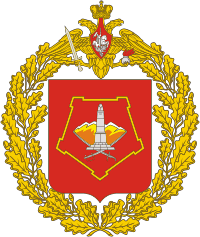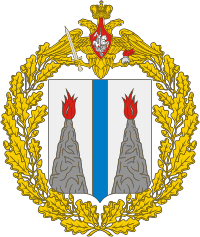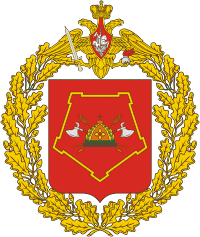
The Russian Airborne Forces is the airborne forces branch of the Russian Armed Forces. It was formed in 1992 from units of the Soviet Airborne Forces that came under Russian control following the dissolution of the Soviet Union.

The Order of Lenin Moscow Military District was a military district of the Soviet Armed Forces and the Armed Forces of the Russian Federation. The district was awarded the Order of Lenin in 1968. In 2010 it was merged with the Leningrad Military District, the Northern Fleet and the Baltic Fleet to form the new Western Military District.

The Leningrad Military District was a military district of the Armed Forces of the Russian Federation. In 2010 it was merged with the Moscow Military District, the Northern Fleet and the Baltic Fleet to form the new Western Military District.

The Baltic Military District was a military district of the Soviet armed forces in the Baltic states, formed shortly before the German invasion during World War II. After the end of the war the Kaliningrad Oblast was added to the District's control in 1946, and the territory of Estonia was transferred back to the Baltic Military District from the Leningrad Military District in 1956. The Baltic Military District was disbanded after the fall of the Soviet Union in 1991 and reorganised into the North Western Group of Forces, which ceased to exist following the withdrawal of all Russian troops from Estonia, Latvia and Lithuania on 1 September 1994.

The Volga–Ural Military District was a military district of the Russian Ground Forces, formed on 1 September 2001 by the amalgamation of the Volga Military District and the Ural Military District. The headquarters of the Ural Military District, located at Yekaterinburg became the new headquarters of the merged district. In 2010 the District was merged with part of the Siberian Military District to form the new Central Military District.

The Far Eastern Military District was a military district of the Armed Forces of the Russian Federation. In 2010 it was merged with the Pacific Fleet and part of the Siberian Military District to form the new Eastern Military District.

The Siberian Military District was a Military district of the Russian Ground Forces. The district was originally formed as a military district of the Russian Empire in 1864. In 1924 it was reformed in the Red Army. After the end of World War II the district was split into the Western and Eastern Siberian Military Districts. In 1956 the district was reformed. In 2010 it was divided between the two newly formed Central and Eastern Military Districts.

The 106th Guards Tula Red Banner Order of Kutuzov Airborne Division, more generally referred to as the Tula Division, is one of the four airborne divisions of the Russian Airborne Troops, the VDV. Based in the city of Tula, to the south of Moscow, it is administratively located within the Western Military District.

The Transcaucasian Military District, a military district of the Soviet Armed Forces, traces its history to May 1921 and the incorporation of Armenia, Azerbaijan, and Georgia into the Soviet Union. It was disbanded by being redesignated as a Group of Forces in the early 1990s after the Soviet Union collapse. The military district formed as a basis of the modern day armed forces of Armenia, Azerbaijan, and Georgia as well as unrecognized polities of Abkhazia, the Republic of Artsakh and South Ossetia.

The Soviet Airborne Forces or VDV was a separate troops branch of the Soviet Armed Forces. First formed before the Second World War, the force undertook two significant airborne operations and a number of smaller jumps during the war and for many years after 1945 was the largest airborne force in the world. The force was split after the dissolution of the Soviet Union, with the core becoming the Russian Airborne Forces, losing divisions to Belarus and Ukraine.

The 169th Training Centre is a division-sized training formation of the Ukrainian Ground Forces. The Training Centre's main task is to prepare young professionals and personnel under contract to the Army Forces of Ukraine.

The 392nd Hero of the Soviet Union Marshal of the Soviet Union V. I. Petrov Pacific Red Banner Order of Kutuzov District Training Center is a training formation of the Russian Ground Forces. It is located at Knyaze-Volkonskoye in the Khabarovsk area.

The 98th Guards Airborne Division is an airborne division of the Russian Airborne Troops, currently based in Ivanovo.

The 7th Guards Mountain Air Assault Division is an elite guards division of the Russian Airborne Troops.
The 27th Separate Guards Sevastopol Red Banner Motor Rifle Division named after the 60th anniversary of the USSR was a Red Army rifle division in World War II which later became a Soviet Army motor rifle division.
The 11th Guards Airborne Division was the name of two separate airborne divisions of the Soviet Airborne Troops. The division was first formed in late 1943 from three airborne brigades and did not see action before its conversion to the 104th Guards Rifle Division nearly a year later. The division was formed a second time in 1948 from a regiment at Ryazan and was disbanded in 1955.

Vasily Filippovich Margelov was a Red Army General who was the commander of the Soviet Airborne Forces (VDV) from 1954 to 1959 and from 1961 to 1979. Margelov modernized the VDV and was a Hero of the Soviet Union.

The 108th Guards Kuban Cossack Air Assault Regiment is a regiment of the Russian Airborne Troops' 7th Guards Airborne Division, based at Novorossiysk. The regiment fought in the suppression of the Hungarian Revolution of 1956, the Warsaw Pact invasion of Czechoslovakia, the War in Abkhazia, the First Chechen War, the War of Dagestan and the Second Chechen War, and the Invasion of Ukraine of 2022.
The 282nd Rifle Division was an infantry division of the Soviet Union's Red Army during World War II, formed twice.
The 56th Rifle Division was an infantry division of the Red Army and later the Soviet Army of the Soviet Union, formed three times.
















